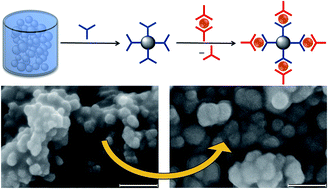当前位置:
X-MOL 学术
›
Nanoscale Adv.
›
论文详情
Our official English website, www.x-mol.net, welcomes your
feedback! (Note: you will need to create a separate account there.)
The SALSAC approach: comparing the reactivity of solvent-dispersed nanoparticles with nanoparticulate surfaces
Nanoscale Advances ( IF 4.6 ) Pub Date : 2019/12/12 , DOI: 10.1039/c9na00488b Sven A Freimann 1 , Davood Zare 1 , Catherine E Housecroft 1 , Edwin C Constable 1
Nanoscale Advances ( IF 4.6 ) Pub Date : 2019/12/12 , DOI: 10.1039/c9na00488b Sven A Freimann 1 , Davood Zare 1 , Catherine E Housecroft 1 , Edwin C Constable 1
Affiliation

|
We demonstrate that the ‘surface-as-ligand, surface-as-complex’ (SALSAC) approach that we have established for annealed nanoparticulate TiO2 surfaces can be successfully applied to nanoparticles (NPs) dispersed in solution. Commercial TiO2 NPs have been activated by initial treatment with aqueous HNO3 followed by dispersion in water and heating under microwave conditions. We have functionalized the activated NPs with anchoring ligands 1–4; 1–3 contain one or two phosphonic acid anchoring groups and 4 has two carboxylic acid anchors; ligands 1, 2 and 4 contain 6,6′-dimethyl-2,2′-bipyridine (Me2bpy) metal binding domains and 3 contains a 2,2′:6′,2′′-terpyridine (tpy) unit. Ligand functionalization of the activated NPs has been validated using infrared and 1H NMR spectroscopies, and thermogravimetric analysis. NPs functionalized with 1, 2 and 4 react with [Cu(MeCN)4][PF6] and those with 3 react with FeCl2·4H2O; metal binding has been investigated using solid-state absorption spectroscopy and scanning electron microscopy (SEM). Competitive binding of ligands 1–4 to TiO2 NPs has been investigated and shows preferential binding of phosphonic acid over carboxylic acid anchors. For the phosphonic acids, the binding orders are 3 > 1 > 2 which is rationalized in terms of relative pKa values (phosphonic acid and [HMe2bpy]+ or [Htpy]+) and the number of anchoring groups in the ligands. Ligand exchange between ligand-functionalized NPs and homoleptic metal complexes gives NPs functionalized with heteroleptic copper(I) or iron(II) complexes.
中文翻译:

SALSAC 方法:比较溶剂分散纳米颗粒与纳米颗粒表面的反应性
我们证明,我们为退火纳米颗粒 TiO 2表面建立的“表面作为配体,表面作为复合物”(SALSAC) 方法可以成功地应用于分散在溶液中的纳米粒子 (NP)。商业 TiO 2 NPs 已经通过用 HNO 3水溶液初始处理然后分散在水中并在微波条件下加热来活化。我们用锚定配体1-4对活化的 NPs 进行了功能化;1-3含有一个或两个膦酸锚定基团,4含有两个羧酸锚定基团;配体1、2和4含有6,6'-二甲基-2,2'-联吡啶 (Me 2bpy) 金属结合结构域和3包含 2,2':6',2''-三联吡啶 (tpy) 单元。已使用红外和1 H NMR 光谱以及热重分析验证了活化的 NPs 的配体功能化。用1、2和4官能化的NP与[Cu(MeCN) 4 ][PF 6 ]反应,用3官能化的NP与FeCl 2 ·4H 2 O反应;已经使用固态吸收光谱和扫描电子显微镜(SEM)研究了金属结合。配体1-4与 TiO 2的竞争结合NPs 已被研究并显示膦酸优先于羧酸锚的结合。对于膦酸,结合顺序为3 > 1 > 2,根据相对 p K a值(膦酸和 [HMe 2 bpy] +或 [Htpy] +)和配体中锚定基团的数量进行合理化. 配体功能化的 NPs 和均配金属配合物之间的配体交换使 NPs 被异配铜 ( I ) 或铁( II ) 配合物功能化。
更新日期:2020-02-19
中文翻译:

SALSAC 方法:比较溶剂分散纳米颗粒与纳米颗粒表面的反应性
我们证明,我们为退火纳米颗粒 TiO 2表面建立的“表面作为配体,表面作为复合物”(SALSAC) 方法可以成功地应用于分散在溶液中的纳米粒子 (NP)。商业 TiO 2 NPs 已经通过用 HNO 3水溶液初始处理然后分散在水中并在微波条件下加热来活化。我们用锚定配体1-4对活化的 NPs 进行了功能化;1-3含有一个或两个膦酸锚定基团,4含有两个羧酸锚定基团;配体1、2和4含有6,6'-二甲基-2,2'-联吡啶 (Me 2bpy) 金属结合结构域和3包含 2,2':6',2''-三联吡啶 (tpy) 单元。已使用红外和1 H NMR 光谱以及热重分析验证了活化的 NPs 的配体功能化。用1、2和4官能化的NP与[Cu(MeCN) 4 ][PF 6 ]反应,用3官能化的NP与FeCl 2 ·4H 2 O反应;已经使用固态吸收光谱和扫描电子显微镜(SEM)研究了金属结合。配体1-4与 TiO 2的竞争结合NPs 已被研究并显示膦酸优先于羧酸锚的结合。对于膦酸,结合顺序为3 > 1 > 2,根据相对 p K a值(膦酸和 [HMe 2 bpy] +或 [Htpy] +)和配体中锚定基团的数量进行合理化. 配体功能化的 NPs 和均配金属配合物之间的配体交换使 NPs 被异配铜 ( I ) 或铁( II ) 配合物功能化。









































 京公网安备 11010802027423号
京公网安备 11010802027423号